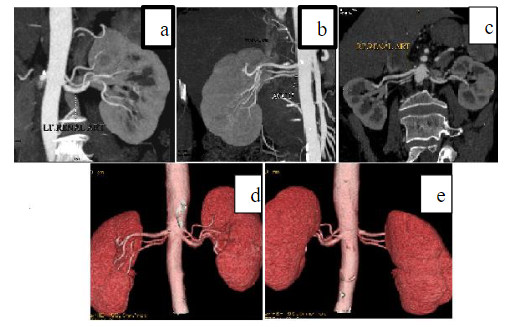Abstract
Background:Renal transplantation is the definitive therapy for the end stage renal disease. This study was undertaken to assess the role of MDCT (64-slice) in the preoperative evaluation of living potential renal transplantation donors for transplantation.
Methods: This prospective one year study included 31 potential living renal donors aged between 22-69 years, sent to the department of radio diagnosis for MDCT using 64-slice CT scanner. Nonionic IV contrast material (130-150mL) was given at a rate of 4-5 mL/sec. Arterial images were acquired by smart prep technique followed by venous phase after 20-25 second delay. Finally, excretory phase was taken after 8 minutes from the start of injection. KV of 120, mAs of 250-790 and collimations of 0.625 mm were used. CT data included determination of renal size, assessment of renal parenchyma (cyst, calculus, mass etc); depiction of renal arterial, venous, and urographic anatomy and identification of important vascular variants. Image processing included three-dimensional volume renderings, maximum intensity projections and multiplanar reformations.
Results:We identified surgically important vascular variants and renal parenchymal abnormalities. Of the 31 subjects evaluated, 4(12.9%) subjects were excluded on the basis of CT findings, due to vascular variants in 3 cases (9.7%) subjects and bilateral microliths in 1(3.2%). The surgical decision of right nephrectomy was taken in 2 (6.4%) cases due to complex vascular anatomy on left side depicted on CT.
Conclusions:Triple phase MDCT provided comprehensive parenchymal and vascular preoperative evaluation of potential living donors for renal transplantation, thus had an impact in deciding the suitability of donor and side of kidney to be harvested for nephrectomy. It provided a road map to the surgeons which helped them in surgical planning to reduce surgical complications.
Link for the publication: https://www.ijsurgery.com/index.php/isj/article/view/312
To view or download the pdf:

